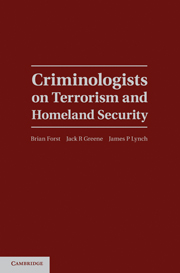1 - Introduction and Overview
Published online by Cambridge University Press: 04 February 2011
Summary
INTRODUCTION
The spectacular attack on the United States on September 11, 2001 brought with it an explosion of books and articles on terrorism in both the academic and popular print media. These writings have focused on political and religious aspects of terrorism; the vulnerability of domestic targets; intangibles like the ethics of preemptive wars to remove governments that support terrorism and ethical aspects of conducting the War on Terror and defending the homeland; and sensational tangibles: dominant figures like Osama bin Laden and Saddam Hussein; bombings of buildings, trains, buses, places of worship, and public markets; assassinations, videotaped beheadings, and other carnage. These vivid images and narratives on terrorism occupied center stage in the presidential election campaigns of 2004 and 2008 and have dominated discussions at the United Nations and other international forums, as well as in major news media venues.
Vivid images and sensational narratives capture the public's attention, but they stifle the objective, comprehensive discussion essential to the process of informed democratic choice and the preservation of legitimacy of governmental action. The accumulated writings and discussions on terrorism have been strikingly deficient in one important respect: Although often acknowledging that acts of terror are acts of crime in most places where they occur, most writings overlook the substantial body of pertinent knowledge that has been produced over the past several decades by criminologists and criminal justice scholars on the nature and sources of crime and aggression, and what works to prevent crime and intervene effectively against it.
- Type
- Chapter
- Information
- Criminologists on Terrorism and Homeland Security , pp. 1 - 14Publisher: Cambridge University PressPrint publication year: 2011



